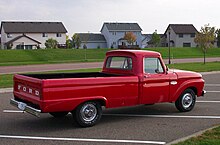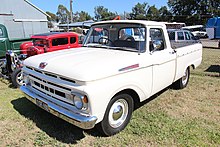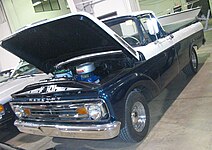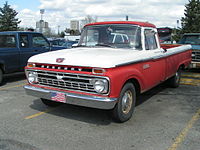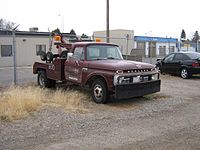
A pickup truck or pickup is a light-duty truck that has an enclosed cabin, and a back end made up of a cargo bed that is enclosed by three low walls with no roof. In Australia and New Zealand, both pickups and coupé utilities are called utes, short for utility vehicle. In South Africa, people of all language groups use the term bakkie; a diminutive of Afrikaans: bak, meaning bowl or container.
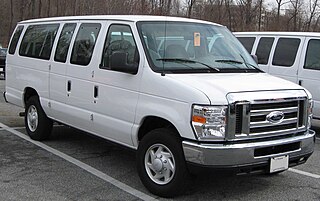
The Ford E-Series is a range of full-size vans manufactured and marketed by the Ford Motor Company. Introduced for 1961 as the replacement of the Ford F-Series panel van, four generations of the model line have been produced. Marketed for both cargo and passenger transport configurations, the E-Series has been designed with multiple design variations for both retail and commercial sale, including vans, and commercial-grade cutaway van chassis and stripped chassis.

The Ford F-Series is a series of light-duty trucks marketed and manufactured by Ford since the 1948 model year. The F-150 is marketed as a range of full-sized pickup trucks positioned above the midsize Ranger but below the larger Super Duty in the Ford truck lineup. Alongside the F-150, the F-Series also includes the Super Duty series, which includes the heavier-duty F-250 through F-450 pickups, F-450/F-550 chassis cabs, and F-600/F-650/F-750 Class 6–8 commercial trucks.

The Ford Excursion is a heavy duty, full-sized SUV that was sold by Ford from 2000 to 2005. The third SUV derived from the Ford F-Series, the model line was the longest and heaviest SUV ever to enter mass production at the time. Slotted above the Expedition in the Ford model line, the Excursion was sold nearly exclusively in North America; limited numbers of the model line were produced for export.

The D series is a line of pickup trucks that was sold by Dodge from October 1960 to September 30, 1993. The same basic design was retained until the October 1993 introduction of a completely redesigned Ram. The D/W series shared its AD platform with the Dodge Ramcharger/Plymouth Trail Duster twins. 4×2 models were designated D, while 4×4 models were designated W.

The C series is a line of pickup trucks sold by Dodge from 1954 until 1960. It replaced the Dodge B series of trucks and was eventually supplanted by the Dodge D series, introduced in 1961. Unlike the B series, which were closely related to Dodge's prewar trucks, the C series was a complete redesign. Dodge continued the "pilot house" tradition of high-visibility cabs with a wraparound windshield introduced in 1955. A two-speed "PowerFlite" automatic transmission was newly available that year. The Dodge Town Panel and Town Wagon also used the new design.

The Ford Super Duty is a series of heavy-duty pickup trucks produced by the Ford Motor Company since the 1999 model year. Slotted above the consumer-oriented Ford F-150, the Super Duty trucks are an expansion of the Ford F-Series range, from F-250 to the F-600. The F-250 through F-450 are offered as pickup trucks, while the F-350 through F-600 are offered as chassis cabs.

The Mercury M-Series is a series of pickup trucks that was marketed by the Mercury division of Ford Motor Company. Produced from 1947 to 1968, the Mercury M series was sold primarily in Canada, as a rebadged version of the Ford F-Series.

The Chevrolet Van or Chevy Van is a range of vans that was manufactured by General Motors from the 1964 to 1996 model years. Introduced as the successor for the rear-engine Corvair Corvan/Greenbrier, the model line also replaced the panel van configuration of the Chevrolet Suburban. The vehicle was sold both in passenger van and cargo van configurations as well as a cutaway van chassis that served as the basis for a variety of custom applications.

The second generation of the Ford F-Series is a series of trucks that was produced by Ford from the 1953 to 1956 model years. Marketed as the "Triple Economy" series, the second-generation F-Series again encompassed a comprehensive range of vehicles, ranging from light-duty pickup trucks to heavy-duty commercial vehicles.

The third-generation of the Ford F-Series is a series of trucks that were produced by Ford from 1957 until 1960. Following its competitors at Dodge and General Motors, Ford widened the front bodywork to integrate the cab and front fenders together. Going a step further, the F-Series integrated the hood into the bodywork with a clamshell design; the feature would stay part of the F-Series for two decades. Although offered previously, the optional chrome grille was far more prominent than before. In the rear, two types of pickup boxes were offered, starting a new naming convention: the traditional separate-fender box was dubbed "Flareside", while "Styleside" boxes integrated the pickup bed, cab, and front fenders together. As before, Ford still offered a low-GVWR version of each model.

The fifth generationof the Ford F-Series is a line of pickup trucks and commercial trucks that were produced by Ford from the 1967 to 1972 model years. Built on the same platform as the fourth generation F-Series, the fifth generation had sharper styling lines, a larger cab, and expanded engine options.

The sixth generation of the Ford F-Series, also known as the "dentside Ford" to enthusiasts, is a line of pickup trucks and medium-duty commercial trucks that were produced by Ford Motor Company from the 1973 to 1979 model years. Produced by Ford in North America, Argentina, and Australia, this is the third and final generation of trucks derived from the 1965 Ford F-Series.

The seventh generation of the Ford F-Series is a range of trucks that was produced by Ford from the 1980 to 1986 model years. The first complete redesign of the F-Series since the 1965 model year, the seventh generation received a completely new chassis and body, distinguished by flatter body panels and a squarer grille, earning the nickname "bullnose" from enthusiasts. This generation marked several firsts for the model line, including the introduction of the Ford Blue Oval grille emblem, the introduction of a diesel engine to the model line, and a dashboard with a full set of instruments (optional). Conversely, this generation marked the end of the long-running F-100, the Ranger trim, and sealed-beam headlamps.

The eighth generation of the Ford F-Series is a line of pickup trucks and light- to medium-duty commercial trucks produced by Ford from 1987 to 1991. While the 1980 cab and chassis was carried over to the new model, the 1987 model was more streamlined, and maintenance items were made simpler. The exterior was facelifted with new composite headlamps, a more aerodynamic front end, and circular fenders. Inside, the interior was given a complete redesign. Rear antilock brakes were now standard, the first pickup truck to boast this. For the first time, all models were produced with straight-sided Styleside beds; the Flareside bed was discontinued except for a small number of early 1987 models using leftover 1986 beds with new circular fenders. In 1991, Ford premiered the 9th gen taillights on the last year of the 8th generation.

The ninth generation of the Ford F-Series is a lineup of trucks that were produced by Ford from the 1992 to 1998 model years. The final generation of the F-Series to include a complete range of trucks from a half-ton F-150 pickup truck to a medium-duty F-800 commercial truck, this is the third generation of the F-Series body and chassis introduced for 1980.
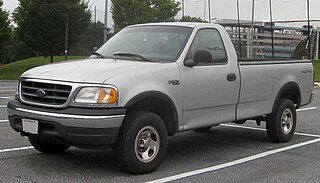
The tenth generation of the Ford F-Series is a line of pickup trucks produced by Ford from the 1997 to 2004 model years. The first ground-up redesign of the F-Series since 1979, the tenth generation saw the introduction of an all-new chassis and a completely new body. In a significant model change, the tenth generation was developed only for the F-150, with the ninth-generation F-250 and F-350 replaced by the all-new Ford Super Duty variant of the F-Series for 1999. An all-new crew-cab configuration debuted in 1999 for the 2001 model year.

The first generation of the C/K series is a range of trucks that was manufactured by General Motors from the 1960 to 1966 model years. Marketed by both the Chevrolet and GMC divisions, the C/K trucks replaced the previous Task Force generation of trucks. The first General Motors pickup trucks developed on a dedicated truck platform, the C/K series included pickup trucks, chassis-cab trucks, and medium/heavy commercial trucks.

The second generation of the C/K series is a range of trucks that was manufactured by General Motors. Marketed by both the Chevrolet and GMC divisions from the 1967 to 1972 model years, this generation was given the "Action Line" moniker by General Motors. As with its predecessor, the second generation C/K included full-size pickup trucks, chassis cab trucks, and medium-duty commercial trucks.

The fourth generation of the C/K series is a range of trucks that was manufactured by General Motors. Marketed by the Chevrolet and GMC brands from the 1988 to the 2002 model years, this is the final generation of the C/K model line. In a branding change, GMC adopted the GMC Sierra nameplate for all its full-size pickup trucks, leaving the C/K nomenclature exclusive to Chevrolet.


